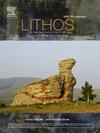Decoding the evolution of Paleo-Tethys: Geochemical and geochronological reinterpretation of the Paleozoic ultra-mafic to felsic rocks in Northeast Iran
IF 2.9
2区 地球科学
Q2 GEOCHEMISTRY & GEOPHYSICS
引用次数: 0
Abstract
The tectono-magmatic evolution of NE Iran records the Paleozoic–early Mesozoic formation and consumption of the Paleo-Tethys Ocean. Debates focus on how the regionally-distributed basement exposures and their diverse evolution settings—such as rifting, oceanic-plateau formation, arc magmatism, and collision—are connected. The compositionally diverse meta-igneous rocks comprise the early Paleozoic Neyshabur complex, the Mississippian–Cisuralian Vakilabad complex (‘Mashhad metamorphics’), the Cisuralian Fariman complex, and the Frasnian–Permian Darreh Anjir complex; the age assignment is preliminary. Combining new field, geochemical, and geochronologic data with published ones, we specify the connection and evolution of these complexes. The Neyshabur complex has dominantly alkaline and subordinate tholeiitic rocks dated at 490–435 Ma (U![]() Pb zircon). In terms of high field strength element rations, such as Nb/Y vs. Zr/Y, they record long-lasting, mantle-plume triggered continental rifting along the northern Gondwana margin. A ∼ 364 Ma (U
Pb zircon). In terms of high field strength element rations, such as Nb/Y vs. Zr/Y, they record long-lasting, mantle-plume triggered continental rifting along the northern Gondwana margin. A ∼ 364 Ma (U![]() Pb apatite) age dates hydrothermal alteration and deformation, possibly recording the integration of this complex into an oceanic accretionary wedge. Circa 195 Ma (Ar/Ar amphibole and plagioclase) metamorphism dates collisional-wedge formation, i.e., the collision of the Central Iranian (Gondwana) and Turan Blocks (Eurasia). In the Vakilabad complex, 281–268 Ma (Ar/Ar amphibole) ages of meta-komatiite/gabbro match those (∼276 Ma; cumulate) of ultra-mafic to mafic rocks of the southern Fariman complex; a ∼ 320 Ma (U
Pb apatite) age dates hydrothermal alteration and deformation, possibly recording the integration of this complex into an oceanic accretionary wedge. Circa 195 Ma (Ar/Ar amphibole and plagioclase) metamorphism dates collisional-wedge formation, i.e., the collision of the Central Iranian (Gondwana) and Turan Blocks (Eurasia). In the Vakilabad complex, 281–268 Ma (Ar/Ar amphibole) ages of meta-komatiite/gabbro match those (∼276 Ma; cumulate) of ultra-mafic to mafic rocks of the southern Fariman complex; a ∼ 320 Ma (U![]() Pb titanite) age of tholeiitic basalt in the Vakilabad complex supports the presence of older rocks, suggested by Carboniferous radiolarian cherts. 188–183 Ma (Ar/Ar mica) metamorphism again dates collisional-wedge formation. The Darreh Anjir-complex rocks with a supra-subduction zone signature record subduction beneath an oceanic plateau within the Paleo-Tethys Ocean. The Vakilabad and the southern Fariman complexes comprise an oceanic plateau built by a mantle plume. This plateau accreted to the hanging-wall plate prior to the terminal collision, detached from the lower plate, blocked the subduction, and caused slab break-off and slab-window formation; the slab window allowed plume material to ascend. The northern Fariman complex documents this process: the rising plume material— depleted by the extraction of OIB-like magma—mixed with fluids from the subducting slab, creating boninite-like magmas. Calc-alkaline andesitic magmas, likely originating from the mantle wedge, coexisted with the OIB-like and boninite-like magmas. Our study provides an evolution model that integrates the various complexes of NE Iran into a common Late Cambrian to Late Triassic evolution of the Paleo-Tethys.
Pb titanite) age of tholeiitic basalt in the Vakilabad complex supports the presence of older rocks, suggested by Carboniferous radiolarian cherts. 188–183 Ma (Ar/Ar mica) metamorphism again dates collisional-wedge formation. The Darreh Anjir-complex rocks with a supra-subduction zone signature record subduction beneath an oceanic plateau within the Paleo-Tethys Ocean. The Vakilabad and the southern Fariman complexes comprise an oceanic plateau built by a mantle plume. This plateau accreted to the hanging-wall plate prior to the terminal collision, detached from the lower plate, blocked the subduction, and caused slab break-off and slab-window formation; the slab window allowed plume material to ascend. The northern Fariman complex documents this process: the rising plume material— depleted by the extraction of OIB-like magma—mixed with fluids from the subducting slab, creating boninite-like magmas. Calc-alkaline andesitic magmas, likely originating from the mantle wedge, coexisted with the OIB-like and boninite-like magmas. Our study provides an evolution model that integrates the various complexes of NE Iran into a common Late Cambrian to Late Triassic evolution of the Paleo-Tethys.

求助全文
约1分钟内获得全文
求助全文
来源期刊

Lithos
地学-地球化学与地球物理
CiteScore
6.80
自引率
11.40%
发文量
286
审稿时长
3.5 months
期刊介绍:
Lithos publishes original research papers on the petrology, geochemistry and petrogenesis of igneous and metamorphic rocks. Papers on mineralogy/mineral physics related to petrology and petrogenetic problems are also welcomed.
 求助内容:
求助内容: 应助结果提醒方式:
应助结果提醒方式:


